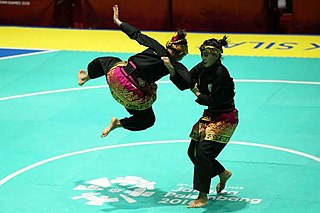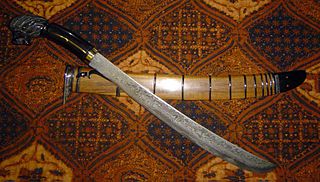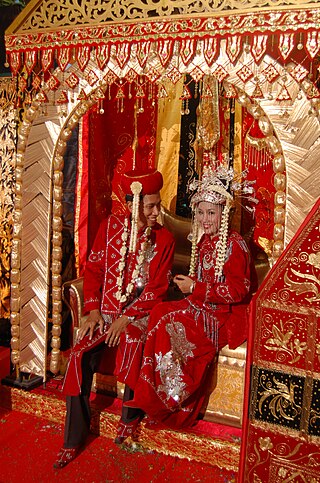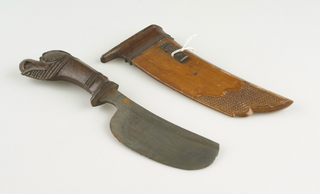Related Research Articles

Kuntao or kuntau is a Hokkien term for the martial arts of the Chinese community of Southeast Asia, specifically the Malay Archipelago. It is most commonly practiced in and associated with Indonesia, Malaysia, the Philippines and Singapore.

A golok is a cutting tool, similar to a machete, that comes in many variations and is found throughout the Malay Archipelago. It is used as an agricultural tool as well as a weapon. The word golok is used in Indonesia and Malaysia. Both in Malaysia and in Indonesia, the term is usually interchangeable with the longer and broader parang. In the Sundanese region of West Java it is known as bedog. In the Philippines, the term gulok, refers to different dagger weapons including the kris.

Pencak silat is an umbrella term for a class of related Indonesian martial arts. In neighbouring countries, the term usually refers to professional competitive silat. It is a full-body fighting form incorporating strikes, grappling, and throwing, in addition to weaponry. Every part of the body is used and subject to attack. Pencak silat was practiced not only for physical defense but also for psychological ends. There are hundreds of different pencak silat styles and schools which tend to focus either on strikes, joint manipulation, weaponry, or some combination thereof.

Betawi people, Batavi, or Batavians, are an Austronesian ethnic group native to the city of Jakarta and its immediate outskirts, as such often described as the inhabitants of the city. They are the descendants of the people who inhabited Batavia from the 17th century onwards.
Silat is a generic name for the martial arts of certain countries in Southeast Asia. There is untold number of Silat systems in Maritime Southeast Asia, with there being over 150 styles recognized styles of pencak silat in Indonesia, and more in aboard.

Kemayoran is a district (kecamatan) of Central Jakarta, Jakarta in Indonesia. It was best known for the former Kemayoran Airport and it has been transforming as a new central business district. As of 2023, it consists of numerous four and five-star hotels, restaurants, premium office towers, hospitals as well as shopping and entertainment centers. Kemayoran is also home to the Jakarta Fair, the largest and longest fair in Southeast Asia that attracts more than 4 million visitors annually.

Sports in Indonesia are popular from both the participation and spectating aspect. Some popular sports in Indonesia are football, futsal, basketball, volleyball, badminton, and the native Indonesian martial art pencak silat. Badminton is arguably Indonesia's most successful sport. Indonesia has won gold medals in badminton in every Olympic Games since the sport was first introduced to the Olympics in 1992, with the exception of two, at the 2012 and 2024 Summer Olympics, although in latter Games, Indonesia clinched a gold medal for the first time in sport climbing and weightlifting, respectively. Indonesia became the first grand winner in Badminton Olympics back then 1992. Indonesia regularly participates in the Thomas Cup, Uber Cup, and Sudirman Cup badminton championships, then became the first nation in history to complete those three titles. Indonesia also regularly participates in regional multi-events sport, such as the Southeast Asian Games, Asian Games, and Olympic Games. Indonesia is one of the major sport powerhouses in the Southeast Asian region, winning the Southeast Asian Games 10 times since 1977.

Silat is the collective term for a class of martial arts from the Nusantara and surrounding geocultural areas of Southeast Asia. It is traditionally practised in Brunei, Indonesia, Malaysia, Singapore, Southern Thailand, Southern Philippines and Southern Vietnam. There are hundreds of different styles (aliran) and schools (perguruan) which tend to focus either on strikes, joint manipulation, weaponry, or some combination thereof.
Lian Padukan is an offensive martial art that specialises in close-range striking. It is one of Malaysia's biggest silat schools and also the most well-known variant of lian or buah pukul. Because of their shared Yunnan origin, lian padukan is very similar to Chinese Wing Chun.

Indonesian martial arts includes a variety of fighting systems native to or developed in the archipelago of Indonesia, both the age-old traditional arts, and the more recently developed hybrid combatives. In the Indonesian language the term bela-diri is used to mean martial art, and in essence the Indonesian fighting arts are meant as one's defence against perceived threat and assault. Other than physical training, they often include spiritual aspects to cultivate inner strength, inner peace and higher psychological ends.

Tapak Suci Putera Muhammadiyah, shortened as Tapak Suci, is an autonomous pencak silat martial arts organization of Muhammadiyah, the modernist, second largest Muslim organization in Indonesia. Tapak Suci is one of the ten 'historic schools' of IPSI, the leading organization of pencak silat in Indonesia.
Beksi Silat is one of the most popular traditional martial arts of the Betawinese. This kuntao-silat hybrid style was originally developed in Kampung Dadap, a village in Kosambi district of Tangerang Regency, Banten Province, Indonesia. The founder of this style combined elements of his ancestral Chinese martial arts with the silat knowledge he received from his Betawi teachers. The style spread through his disciples to the coastal Betawinese and the Benteng Chinese around Kampung Dadap. Eventually, the silat style also reached Petukangan Selatan in South Jakarta and Batujaya in Tangerang.
The men's tanding class B competition at the 2018 Asian Games took place from 23 to 27 August 2018 at Padepokan Pencak Silat, Taman Mini Indonesia Indah, Jakarta, Indonesia.
The men's tanding 65 kilograms competition at the 2018 Asian Games took place from 23 to 27 August 2018 at Padepokan Pencak Silat, Taman Mini Indonesia Indah, Jakarta, Indonesia.
The men's tanding 75 kilograms competition at the 2018 Asian Games took place from 23 to 29 August 2018 at Padepokan Pencak Silat, Taman Mini Indonesia Indah, Jakarta, Indonesia.
The women's tanding 60 kilograms competition at the 2018 Asian Games took place from 23 to 27 August 2018 at Padepokan Pencak Silat, Taman Mini Indonesia Indah, Jakarta, Indonesia.
The women's tanding 55 kilograms competition at the 2018 Asian Games took place from 23 to 29 August 2018 at Padepokan Pencak Silat, Taman Mini Indonesia Indah, Jakarta, Indonesia.
Cingkrik Silat is one of the traditional pencak silat styles of the Betawinese. This style originally came from the Rawa Belong area, which is now part of the Kebon Jeruk subdistrict, West Jakarta, Indonesia. This style was created by Ki Maing around the 1920s. Cingkrik Silat has now been spread to various places in Jakarta through many silat schools opened by its practitioners.
Silat Sabeni Tenabang, often shortened as Sabeni silat, is one of the Betawinese pencak silat styles. The style was created by its eponymous founder Sabeni bin Canam around the end of the 19th century, when Indonesia was still in the Dutch colonial period. It was originally developed in the Tanah Abang district, now part of Central Jakarta, Indonesia.

The Bendo is a traditional bladed tool from Java, Indonesia. Betawi people would regard the Bendo as a domestic household tool and sometimes it is also called golok dapur, which means a "kitchen golok".
References
- 1 2 3 4 5 6 7 8 9 10 11 12 13 14 Nawi, G. J. (2016). Maen Pukulan Pencak Silat Khas Betawi: Maen Pukulan Pencak Silat Khas Betawi (in Indonesian). Yayasan Pustaka Obor Indonesia. pp. 126–135. ISBN 9789794619834.
- 1 2 3 4 Green, Thomas A.; Svinth, Joseph R. (2010-06-11). Martial Arts of the World: An Encyclopedia of History and Innovation [2 volumes]: An Encyclopedia of History and Innovation. ABC-CLIO. p. 315. ISBN 9781598842449.
- 1 2 3 4 Shahab, Alwi (2006). Maria van Engels: menantu Habib Kwitang (in Indonesian). Penerbit Republika. pp. 187–190. ISBN 9789793210728.
- ↑ Yayasan Untuk Indonesia (2005). Ensiklopedi Jakarta: buku 2. J-P (in Indonesian). Pemerintah Provinsi Daerah Khusus Ibukota Jakarta, Dinas Kebudayaan dan Permuseuman. p. 333. ISBN 9789798682513.
- ↑ An alternative names mentioned were Kwee Tang Kiam and Kwik Tang Kiam.
- 1 2 3 4 5 6 "PS. Mustika Kwitang". psmustikakwitang.blogspot.com (in Indonesian). Retrieved 2018-10-29.
- 1 2 3 Draeger, Donn F. (2012-03-06). Weapons & Fighting Arts of Indonesia. Tuttle Publishing. ISBN 9781462905096.